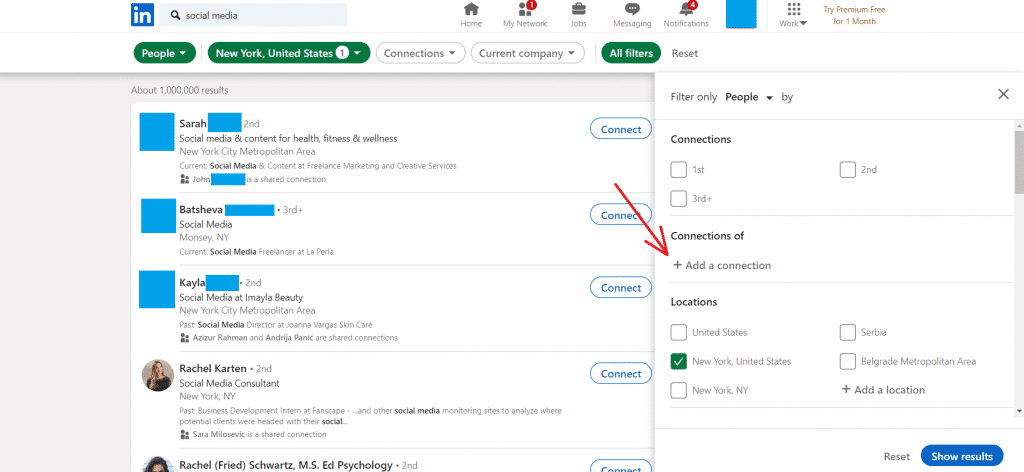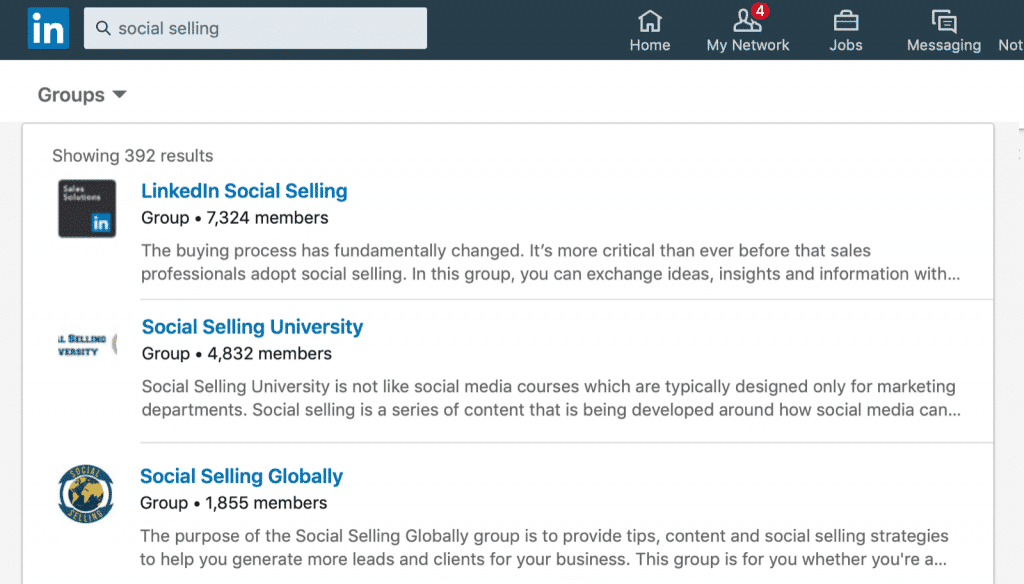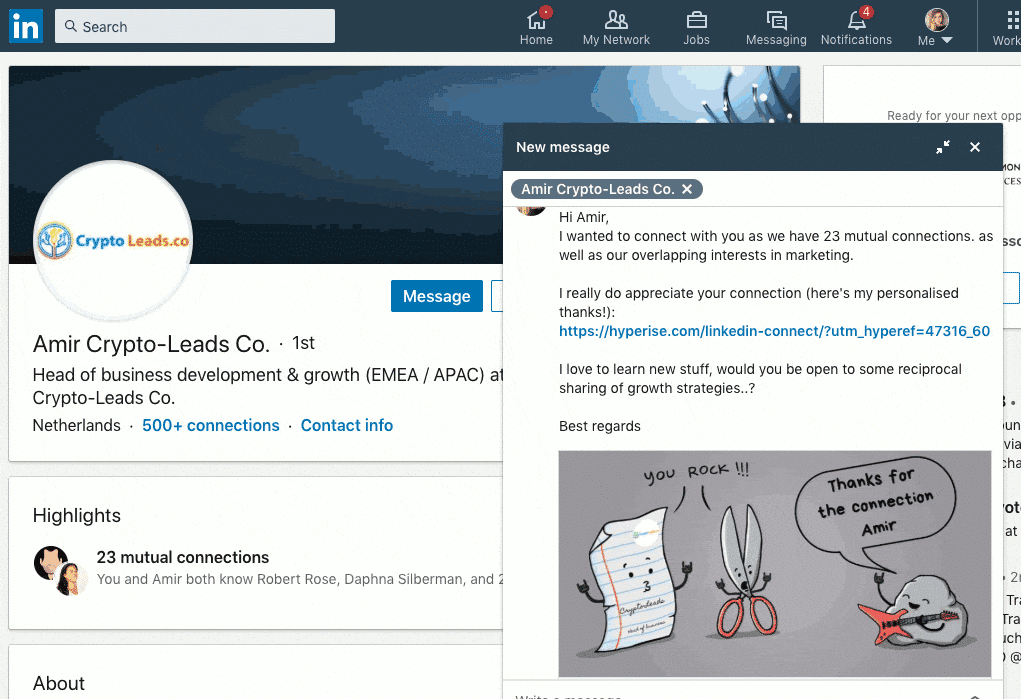Outbound prospecting is a powerful and effective way to generate high-quality leads that you can quickly convert into paying customers.
However, many people believe that outbound prospecting is no longer a good sales tactic to use.
This is simply not true.
Outbound prospecting is still invaluable for getting quick results, diversifying your portfolio, or building long-lasting relationships with important clients.
To get outbound prospecting right, you need to develop effective strategies and spend time perfecting your outreach efforts. You’ll also need to consider how you can get your outreach to stand out from the rest.
In this article, we’ll explain what outbound prospecting is and why it is still a valuable tool today. We’ll also share four top strategies for successful outbound prospecting that you can try in 2024.
What Are Outbound Sales?

Outbound sales prospecting—or outbound sales—is an approach where businesses initiate contact with potential customers, or leads, to pitch their product or service.
The primary objective is to introduce prospects into the sales funnel and convert them into paying clients.
An outbound prospecting strategy is the traditional approach to sales. People working in telemarketing, door-to-door salespeople, and traveling salespeople are all examples of outbound prospecting efforts.
This type of prospecting is what’s referred to as “cold outreach.” This means that the lead has not contacted the company before their sales team contacted them. Cold calls and cold emailing fall into this category.
What Is the Difference Between Inbound and Outbound Prospecting?

Source: Freepik
Outbound sales are different from inbound sales. Inbound prospecting is all about attracting customers to your business.
An outbound strategy includes creating valuable content and experiences tailored to potential clients.
The aim is to build brand awareness and attract new business via channels like blogs, search engines, and social media. Customers find you through these channels when they’re interested in your product or service.
While outbound sales are sometimes considered pushy and aggressive, inbound sales are thought of as subtler and possibly more effective.
Conversion rates for outbound sales techniques are typically lower, so many people prefer a less aggressive approach.
But, inbound sales have a significant downside, too—it takes much longer to see any results.
Sales teams don’t do the heavy lifting for an inbound approach to work. Instead, marketing teams must create content regularly to attract new leads.
Outbound prospecting is the way to go if you want to grow your brand faster, reach specific users, and generate revenue.
Is Outbound Prospecting Dead?

Source: Freepik
The short answer is no. Outbound prospecting gets a bad rap because it’s always assumed that your prospects are either unfamiliar with or uninterested in your brand.
The perception is that outbound sales are spammy and ineffective because you’re reaching out to someone out of the blue.
Sure, those who don’t research their target audience and send generic emails will be regarded as spammers. But not all outbound prospecting is bad.
When discussing outbound sales, we’re not talking about a traditional approach. Successful outbound prospecting is a carefully executed strategy where you don’t simply reach out to your entire existing customer base.
You go through a precise process of generating and qualifying leads, you make lists and audience segments, and then you reach out to them with personalized messages and tailored offers across email and social media channels.
Think of it as a direct marketing channel where you identify the right customers and introduce them to your company. Sounds much more convincing than just picking up the phone and cold-calling, right?
| 🚀 Need More Convincing? Here are some outbound prospecting statistics: ✔️ 50% of decision-makers prefer to be contacted over the phone. ✔️ 61% of marketers say their business relies mostly on outbound marketing efforts. ✔️ 62% of buyers want to hear from sellers when they are actively looking for a solution to solve a problem. |
The Best Outbound Prospecting Strategies of 2024
Now that you know more about this strategy, here are our top outbound prospecting tips for you to try yourself:
Strategy #1: Get creative with lead hunting on LinkedIn

Source: Freepik
The first step to outbound sales success is to find high-quality leads. As we mentioned above, it’s about reaching the right people rather than reaching everyone.
You need to focus on nurturing leads that are more likely to convert. This approach will yield better results, enhance your brand’s credibility, and protect your reputation.
A great place to start is on LinkedIn. There are more than one billion members on the platform with over 214 million users in the U.S. alone. This makes it an excellent platform to find high-quality leads. Here’s how:
✔️ Connect with friends of friends

With just a few clicks, you can easily find potential leads among your current LinkedIn connections’ networks. To do this:
- Enter a relevant job title like ‘social media manager’ into the search bar and select ‘People.’
- Click ‘All filters’ and choose ‘Add connections of.’ This allows you to start typing the name of a current connection and view their connections.
You can add multiple connections in this field, potentially giving you hundreds of leads from the same industry who may be more interested in your offer due to their relationship with your existing LinkedIn connection. Once you’ve built a solid list, exporting the data ensures you don’t lose access to valuable leads if LinkedIn limits your searches or restricts your account activity.
✔️ Look for contacts in LinkedIn groups

The next thing you can do to generate high-quality leads is to scrape contacts from LinkedIn and Facebook groups. These are usually communities highly dedicated to specific fields, so you can join a group from your industry and scrape contacts from it using an automation tool like TexAu. That said, mastering techniques for web scraping without getting blocked can greatly enhance your ability to access valuable data securely.
For instance, a quick search for ‘social selling’ on LinkedIn revealed almost 400 groups, with nearly 15,000 members in the top three. If you’re offering anything related to social selling, these groups are teeming with potential leads.
You can apply the same approach to Facebook groups.
You can also use LinkedIn’s advanced search function to find qualified leads from related industries with specific educational backgrounds or who work for certain employers.
Whatever you do, one thing should matter more than anything else: find those leads who are closely connected to the industry you’re trying to target and focus on them.
| 🚀 Pro-Tip: Use LinkedIn Prospecting Tools Once you’ve created a solid list of high-quality leads, you can use prospecting tools designed for LinkedIn to engage with them. This helps you automate outbound prospecting, saving you time and resources. |
✔️ Don’t just send connection requests
Wherever possible, ensure you send a message with your connection requests on LinkedIn. This personalized approach shows the recipient that you’ve made an extra effort to connect with them, which may give you a better chance of your request being accepted.
There are several ways to personalize your connection requests—which we will discuss later in this article. However, you should research the person you want to connect with to show them in your message that you’ve taken the time to get to know them.
You can do this by mentioning their job title, the company they work for, or any noteworthy awards they’ve won. If you enjoyed one of their LinkedIn posts or have a mutual connection, you can leverage this in your connection request message.
Strategy #2: Focus on email marketing

Source: Freepik
Email is one of the best channels to engage all those quality leads you collected. In fact, 31% of marketers believe it’s the best channel to nurture leads.
Here are some tips to make your email marketing work for you:
✔️ Use email finding tools
If you want to build a good email list, an email-hunting tool will save you a lot of time.
Let’s say you scraped the contacts from a Facebook group, but only a handful of these profiles have their email addresses displayed.
An email finder will help you get their email addresses using their name and domain.
| 🚀 Pro-Tip: Stay Complaint when Finding Email Addresses It’s important to use email finder tools ethically and comply with privacy laws and regulations in your state. |
✔️ Craft a good subject line
There is a big chance that your prospects will ignore your emails if you don’t do something to stand out. One of the best ways to grab their attention is to use smart subject lines to improve your open rates.
Some tips for crafting great subject lines include:
- Personalizing it with the recipient’s name, job title, or business name.
- Touching on a pain point that you know the reader has.
- Creating a sense of urgency as to why the email should be opened and acted on.
- Keeping them short so that they display correctly when an email is received.
| 🚀 Pro-Tip: Best Practices for Email Subject Lines Check out these best practices for email subjects by MailChimp based on an analysis they conducted. |
✔️ Send automated emails to stay in touch with target customers
An automated email is a message that’s sent out automatically based on specific triggers or scheduled times.
These can include:
- Welcome emails when someone signs up for a newsletter.
- Confirmation emails after a purchase.
- Reminders when a user abandons their shopping cart.
The content, timing, and frequency of these emails are predetermined, allowing businesses to maintain consistent and timely communication with their audience without any manual work.
✔️ Make your emails mobile-friendly
More than 1.7 email users access their emails on their mobile phones. Keep this in mind and optimize your emails for smartphones. Your subject lines should be short, your copy concise, and your calls to actions (CTAs) prominent.
✔️ Use clear calls-to-action (CTAs)
If someone opens your email, how will they know what action you want them to take if you don’t make this clear?
Email marketing is only effective when you include solid calls-to-action (CTAs) in the content of your emails.
You can include CTAs as buttons or links that can be tapped or clicked on for the reader to follow your desired next step.
✔️ Keep your email content concise
People receive hundreds of emails each day. No one has time to read through long emails, especially when attention spans are becoming more limited.
To ensure your recipient reads your full email and takes action, you need to keep the content of your email short.
Try to communicate your message in as few words as possible and make your email easy to skim read by including:
- Headings.
- Bullet points.
- Visuals that break up walls of text.
✔️ Start with a good introduction
The introduction of your email is how you entice your recipients to keep reading, so it needs to be good.
You can use your introduction as an opportunity to show the reader that you’ve done your research to get to know them. You can do this by mentioning:
- Any mutual connections you have.
- Their job title.
- The name of the company they work for.
- Any projects they’ve worked on.
We’ve also found that compliments work well in email introductions (if they’re genuine, of course). If you’ve come across a LinkedIn post, research project, or blog post the recipient has created, use your introduction to compliment them on this.
Strategy #3: Personalize all your outreach efforts

Source: Freepik
89% of marketers see a positive return on investment (ROI) when they use personalization in their outbound prospecting campaigns.
For this reason, personalization should be your top priority, whether you reach out to your prospects through email, social media, or a sales prospecting tool.
The last thing you want to do is send the same email to all your prospects. You must explain how you got their contact information, what connects you to them, and why your offer is perfect for them. Mention all of these things in your communication, and be honest.
Also, don’t forget to mention their name—there’s nothing more annoying in an email or LinkedIn message that starts with “Dear Mr. or Mrs. or Miss.” It makes your prospects feel like numbers in your revenue column.
A good way to take this approach one step further is image personalization.
Personalization allows you to add a new dimension to your outreach campaigns and surprise prospects. Instead of ignoring your message, they’ll be more likely to be intrigued and check out your offer.
So, what is image personalization?
It’s the process of using your prospects’ data, like their name, job title, or website, to send them a message that features these details in a personalized image.
Here’s how we used it in our LinkedIn outreach campaign (check out the replies, too):

You can also use it to personalize images in your emails and even your website content.
With Hyperise, you don’t need coding or design knowledge to create these personalized visual elements. Everything is drag-and-drop, so you can easily craft personalized messages using our streamlined interface.
When you apply image personalization to your outreach strategy, you can end up with a message that looks like this:

In this message, everything is personalized. Both the image and the opening line mentioning the prospect’s name. You address the thing that you have in common, and you talk about their interests.
As you can see, this goes far beyond old-school outbound prospecting. The leads are high-quality, and the messages are highly personalized. With this approach, you’ll be much closer to getting the open and reply rates you want.
| 🚀 Pro-Tip: Personalize Everything with Hyperise Using the Hyperise toolkit, you can personalize images, CTAs, text, videos, GIFs, landing pages, and so much more! This is the best way to ensure your outbound prospecting efforts are successful. Register for a free trial of Hyperise and test out these strategies yourself! |
Strategy #4: Use data and metrics to inform your decisions

Source: Freepik
Once you’ve started outbound prospecting, you need to know if your efforts are paying off. You also need to identify if something isn’t working so you can improve it.
Using the right analytics tools, you can get great insights into how your outbound prospecting is performing. That way, you can adjust your strategy where needed and make the most out of your outreach efforts.
For example, you might have one group of leads that consistently performs better than other groups.
When studying your analytics, you might learn that who you thought of as your primary audience wasn’t actually that interested in your offer.
You also might learn that the messages that looked the best didn’t perform as well as you thought they would. Information like this could help you craft better messages going forward.
Observe, learn, and adjust!
Here are some analytics you should always keep an eye on:
✔️ Conversion rate
This number shows you the percentage of your new leads who went through the entire funnel and ended up purchasing your product or service.
You can calculate conversions by dividing the number of sales by your total number of leads and then multiplying this number by 100.
✔️ Open and response rates
These show how many people actually opened or responded to your emails or connection requests. A low conversion rate can indicate a problem with your product or website.
A low open or response rate is almost always due to low lead quality or a poorly composed message.
✔️ Bounce rate
If you have a website you want your prospects to visit, it’s good to keep an eye on your bounce rate.
Your bounce rate is the percentage of visitors who accessed your site and left without viewing another page. It’s a good indicator of whether or not your website is properly optimized.
According to FullStory, a bounce rate of 40% or lower is considered good, while a bounce rate of 55% or higher is considered less ideal and may indicate that improvements are needed.
You can focus on many other metrics, but these should definitely be in your top five. When you choose your prospecting tools, ensure they have advanced analytics to help you make informed decisions.
The Perfect Tool for Outbound Prospecting
You now know that outbound prospecting is still an effective strategy. While many assume this tactic is dead, it still works in 2024.
However, you need to implement personalization to take your outbound sales strategy to the next level. Personalization makes prospects feel like you truly care about them and that they’re not just another email address in your database.
If you want to see success with outbound prospecting, you can use tools like Hyperise to hyper-personalize images, GIFs, text, calls-to-action, QR codes, your website, and much more.
With our tool, you don’t need any tricky coding or much effort to create beautifully personalized visual elements. Instead, you’re just a few clicks away from impressing your prospects with personalized content that truly resonates with them.
Visit our website to register for a free Hyperise trial today. We’d love to show you how powerful hyper-personalization can be in your outbound prospecting campaigns.
Last Updated on May 15, 2024
